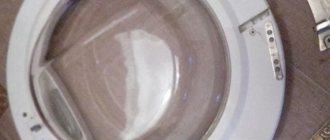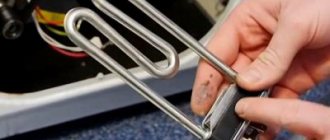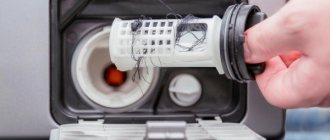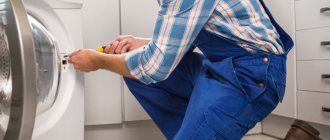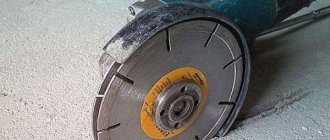What are shock absorbers and dampers?
Dampers are used in more modern washing machines.
They differ from shock absorbers in that they consist only of a spring. The shock absorber has a more complex design. Shock absorber device:
- Cylinder.
- Return spring.
- Piston with rods.
- Gaskets.
This type of shock absorber is called spring-piston, and is a cylindrical metal device containing a bushing. The rod moves in it during operation. On its upper part there is a special fit for rubber inserts, with the help of the latter it is connected to the drum.
A piston with a gasket is fixed at the base of the rod. It is impregnated with a special lubricant, which does not dry out for a long time and increases the friction force during movement. The work of the shock absorber is as follows:
- With sharp jumps, linear movement of the rod occurs.
- The piston, pushed by the rod, moves inside the cylinder.
- Lubrication creates the necessary conditions for movement so that it does not slip idle.
- When weakening occurs, the rod returns to its original position.
And everything repeats itself again.
The dampers have the same cylindrical design, only there is only a piston inside the cylinder, and there are holes in the walls for air to escape. The piston is equipped with a gasket that replaces the lubricant in the shock absorbers.
Dampers are divided into two types:
- Collapsible. They replace the compressed liner.
- Non-separable. The damper must be completely replaced.
The load that both of these devices can withstand varies from 100 to 150 newtons.
Design features of dampers
Dampers in washing machines are also used in combination with suspension springs, but their structure does not contain elements that are not very strong. In fact, this is also a steel cylinder, although it is not a rod with a piston that moves through its cavity, but simply a piston with holes in the walls to remove excess air.
The damper piston is also equipped with a friction-type gasket. It is made of porous polymer and impregnated with a non-drying lubricant that creates additional friction. There can be two or even more gaskets in the damper, it all depends on the characteristics of the device.
Both the metal cylinder and the damper moving along its cavity are equipped with rubber bushings on the outer edges, with the help of which the shock-absorbing devices are connected to the bottom of the machine and to the tank.
Dampers are available in two versions:
- Collapsible. To repair this type, most often it is enough to simply replace the pressed gasket.
- Non-separable. Their edges are rolled. Repair of this type consists of replacing the device.
The values of the maximum permissible force possible for a particular shock-absorbing device are indicated on the damper or shock absorber housings. Typically the load varies in the range of 50 - 150 newtons. When operating in the manufacturer-guaranteed mode, washers rarely exceed these limits.
When buying a new shock-absorbing device for replacement, you should not exceed the characteristics indicated on the previous part. If 100 N is indicated on the case, then there is no need to delude yourself that an element with 150 N will last longer; you need to purchase exactly the same one or with similar indicators.
Option 1: disassemble the case
- Unplug the machine and turn off the water supply.
- Open the laundry hatch. Remove the clamp - a ring with a screw or spring that tightly secures the rubber seal:
- on screw ones - loosen the screw;
- on spring ones - pry the spring with a screwdriver and pull it towards you.
- Bend the edges of the cuff seal and pull it out. Behind the cuff in the right center there is a block from the machine door lock wires - this also needs to be disconnected.
- Open the drain filter plug at the bottom of the machine. Disconnect the drain hose. Unscrew the screw that holds the casing and remove the casing. Then remove the screw that secures the front panel.
- Let's move on to the back of the machine. Unscrew the two top screws that hold the washer cover in place. Remove the cover - pull it towards you, lifting it up a little.
- Pull out the powder tray. There are two more screws under it - unscrew them.
- Remove any existing screws behind the control module panel.
- Carefully lift the control panel up. You will know that you have removed it when you hear the characteristic click of the latches. Once you have the panel in your hands, place it on top of the machine without removing the wire.
- Remove the screws holding the front panel. Slide the panel itself up and pull it out.
- Access to shock absorbers is open! Take pliers and remove the fasteners - the plastic “fingers” on the top and bottom of the part. Remove the parts from the supports.
- Install new parts.
- Reassemble the machine in reverse order.
If you can’t easily get to the necessary details, move on to option 2.
More nuances of disassembling washing machines are in a separate article, here.
Universal instructions for disassembling washing machines: 23 videos for all brands
Troubleshooting
Shock absorbers prevent the device from sliding on the floor during washing and spinning. They reduce the vibration coming from the drum; without them, it would jump during washing, and the drum spinning at high speeds would damage the structure.
After many years of service, shock absorbers lose strength, so it is recommended to periodically carry out diagnostics, otherwise the washing machine may break at the most inopportune moment.
Diagnostics for vertical loading
If shock absorbers or dampers are damaged, a specific noise is heard - knocking during washing, coming from inside. Possible distortions of the housing or strong vibration.
Diagnostics for vertical loading is carried out as follows.
- Press the top of the tank with your hand. If you feel that there is no resistance, and after you remove your hand it continues to swing, then it is time for repairs.
- Watch how the drum rotates. If it’s tight or squeaky, it means the parts are not lubricated at all.
- Disassemble the machine, remove the cover from the back. Press down on the tank again and forcefully lower it down, then quickly release it. If the tank jumps and no longer moves, then the shock absorbers are normal.
These simple diagnostic methods will help you determine whether your washing machine's dampers need repair.
Front loading diagnostics
Diagnosis of a front-loading washing machine occurs in a different way.
- Press firmly on the tank at the top and look at the hatch seal lip. If folds form on it, then repair is needed.
- Be sure to note how much the tank drops as you press.
Normally, when pressing, folds should not appear on the seal and the tank should not sag when it is loaded.
If all these defects are found, the device should be repaired.
Replacing shock absorbers with removing the tank
The second option requires almost complete disassembly of the entire washing machine. To do this, it is necessary to remove all protective covers and the upper part of the housing, and then remove the powder tray. If there is a top part of the control panel, you need to remove it too. After this, you need to remove the springs and disconnect all the terminals from the tank. After this, you need to remove the tank and replace it according to the repair manual for the specific washing machine.
READ MORE: Rating of the best MFP printers with CISS for 2020
It is worth noting that such repairs require quite a lot of physical strength and good skills in handling equipment. If this is your first time repairing a washing machine, then it is best to refrain from this endeavor and carry out easier repairs in the future. In a situation where the tank is removed, you need to contact a specialist or even buy a new car, because... such repairs can cost up to 80% of its cost.
Is it possible to make damper grease at home?
In principle, you can make everything at home. Even high molecular weight lubricant. A simple analogue of damper lubricant made at home is a solution of synthetic resin in oils, for example, industrial oil. It’s even easier to dissolve rosin in oil to the desired consistency. True, such a solution only works at positive temperatures and not higher than +50 C, since after this the resin begins to decompose and can become coked, which to a certain extent will only cause harm. Therefore, it is recommended to use a mixture prepared at home in cases where there is an urgent need or some kind of knocking is very annoying, followed by replacing it with normal lubricant. Damper grease can be purchased on the Internet or at manufacturer dealerships.
Replacing shock absorbers without removing the tank
In the first option, shock absorbers can be replaced without removing the tank. To do this, you need to disconnect the machine from the power supply and water supply system. After this, you need to put the device “on its butt,” remove the front part of the body (if possible) and, using aerosol lubricant, screwdrivers and wrenches, remove the old shock absorbers.
After you have removed the old components, you should contact either an official spare parts dealer or a specialized store. Ideally, write down the complete model and serial number of the machine, take the removed parts with you, and speak with the seller in person, who can select the necessary replacement parts.
The final phase is to assemble the machine, connect it to water and electricity, and then proceed to test its functionality. Moreover, it is important not only to check the machine with an empty tank, but also to carry out an additional wash cycle with the tank loaded to find out how well the shock absorbers cope with their task.
High temperature lubricant Litqui Moly 50 Litho HT 3400
The lubricant is intended for loaded bearings and assemblies. Operating range – -30С- +160С, briefly allowed up to +250С. It is used in components of cars, trucks, agricultural machinery, and tractors.
The grease is ideal for the initial filling of bearing races when changing them and for regular repressing. It is used to lubricate parts that operate under load and are heated. In cars, such parts include wheel bearings, suspension joints, and spring supports.
Well suited as a universal lubricant. Does not change its viscosity when heated, is not subject to melting and leakage from nodes, good adhesion. Supplied in tubes of 200 and 500g. containers of 5 kg. Parameters of the packaged goods in the container: Weight, 5.71 kg; Length – 202 mm; Height 25mm.
The results of the heating test and its lubricating properties of the grease can be viewed in the video below.
| Attention Bearing Buyers Dear customers, send your questions and requests for the purchase of bearings and components by email or call now: Delivery of bearings throughout the Russian Federation and abroad. Bearing catalog on the website |
Attention Bearing Buyers
Dear customers, send your questions and requests for the purchase of bearings and components by email or call now: +7 [email protected] Delivery of bearings in the Russian Federation and abroad. Bearing catalog on the website
themechanic.ru
Replacing suspension springs
Another shock-absorbing element is steel springs, with the help of which the drum is suspended inside the housing. They are located in the upper part of the machine body. These are quite reliable elements, the replacement of which is required extremely rarely. Sometimes the spring hooks pop out of the eye holes due to vibration; to easily install them in place, just lift the drum.
Not only the quiet operation of the washing machine, but also protection from vibration loads of other elements depends on the reliable operation of the dampers. If shock absorbers break down, it is best to replace them in a service center with a warranty.
Preparation
Before you start replacing Bosch shock absorbers, you need to prepare. At this stage, perform the following actions:
- The washing machine is disconnected from the electricity and the water supply tap to the device is closed.
- The laundry is taken out of the drum.
- The washing machine is pulled out to allow access to the device from all sides.
It is also necessary to ensure that you have tools and new dampers for replacement. The required set of tools includes:
- screwdriver;
- set of heads;
- drill 13 mm;
- screwdrivers;
- awl;
- pliers.
You will also need 2 13mm bolts and nuts to secure them.
How to repair washing machine shock absorbers
New vibration dampers for modern cars cost from 500 to 3,000 rubles per pair, depending on the model. Although this amount is not critical, in some cases it is possible to restore the old shock absorber. Owners of washing machines simply remove the remaining sealing elements from the body. Using the selection method, homemade parts from cut rubber pipes, leather belts or pieces of linoleum are installed in their place.
The main thing with such a restoration is to achieve a high-quality seal of the connection of the rod in the body. The cut parts are fixed in the body; for smoother operation, the connection is lubricated with technical or other grease. This type of repair can hardly be called reliable. In the best case, such a damper will last several dozen washing cycles, and malfunctioning or jamming will lead to breakage of other parts.
With modern repairs, the faulty damper element assembly is replaced with a new one, and both shock absorbers must be replaced, even if one of them is in perfect condition!
Step-by-step repair guide
A washing machine with a damaged shock absorber or a worn damper seal, of course, can still work for some time without carrying out repair operations.
But it should be remembered that without vibration damping, some extremely important parts and mechanical systems may crack or become detached. The tank and piston assembly suffer the most from this.
Making a new gasket for the damper
If noise and significant knocking are detected in a washing machine with dampers, it is often enough to change the sealing gaskets. To do this, you need to partially disassemble the machine and simply disconnect the device.
Then, according to plumbing rules, you should simply cut out new gaskets from textolite or a piece of rubber of suitable thickness. After which the gaskets are replaced.
A used rubber brake pad for a car is ideal as a starting material for making your own gaskets. It is better to select the rubber thickness according to the actual size of the gap between the tank and the shock-absorbing device.
The simplest option for replacing shock absorbers
In the vast majority of situations, washing machine shock absorbers must only be completely replaced. Moreover, repairmen advise changing the entire set, and not just one device.
There is logic in the statements of experienced masters. After all, during the working process, all shock absorbers wore out approximately equally. After replacing only one device during the washing/spin period, the vibrations will be damped unevenly, which will very soon lead to breakage and abrasion of previously undamaged elements.
How to repair a broken shock absorber
We warn you: self-repair, lubrication, or installation of a repair kit will only help for a while. It is safer to replace the shock absorbers for your washing machine with new ones than to try to restore them.
Let's assume you have already disassembled the machine and removed the necessary parts. Let's make a new gasket instead of the old one:
- Take a flat-head screwdriver. Press the plastic ring onto the part.
- Now you have access to the rubber gasket in the lubricant. Get it out.
- Clean the entire shock absorber thoroughly.
- Take a leather belt and cut 2 strips from it. The length and width of the strips are based on the gasket. The thickness of the strips should be 3.5 mm. The length should be “overlapping” so that the strips form a “ring” inside the part.
- Check the density. The rod - the metal sleeve - should move with noticeable force.
- Put a little thick lubricant inside so that the spare part does not rust and the movement is not “dry”.
- Reinstall both parts. Assemble the machine.
READ MORE: How to check the tachometer (Hall sensor) in a washing machine
Dismantling and installing the part
How to remove shock absorbers? In fact, there is nothing complicated about it. To remove the dampers, you need to remove the “top” and the rear panel of the case, which is very simple to do. On some Bosch models, you will have to “unhook” the front wall to gain access to the parts. Then the algorithm of actions will be as follows:
- remove the lid from above. To do this, unscrew the two bolts, lightly press on it and slide it back;
- remove the detergent dispenser;
- remove the lower decorative panel hiding the garbage filter;
- Unscrew the bolts securing the control panel. Carefully place it on top of the automatic machine so as not to break the wires connecting the part to the control module;
- open the hatch door, remove the metal clamp holding the cuff, insert the elastic into the drum;
- Unscrew all the screws securing the front wall of the machine;
- disconnect the hatch locking device from the body;
- remove the front panel;
- find the dampers. They are located below, under the washing tank;
- unscrew the bolt securing the shock absorber or damper to the body (it may be necessary to remove the latch);
- remove the shock-absorbing elements.
Then you need to examine the disconnected shock absorbers and see what exactly is broken. You may not need to purchase new spare parts; repairing the part will suffice. If not, all that remains is to purchase and install serviceable components by performing the described steps in reverse order.
A pair of dampers must be replaced, even if only one of them is broken.
How to check when purchasing and replace a shock absorber?
When buying a new part, as well as when dismantling an old one, you need to compress the damper several times. If the compression is tight, then everything is in order. If it is easy, this indicates wear of the seals.
Important! Two elements are changed at once, regardless of the degree of wear.
Now you know how to restore and repair shock absorbers in a washing machine. If you don’t want to bother with repairs, then buy a new set of spare parts and install them in the washing machine.
Rules for selecting spare parts
Each washing machine model has its own design features. Therefore, there are no universal spare parts that fit all washing machines.
When purchasing new shock absorbers, it is advisable to make sure of their quality. When compressed, the part must provide resistance.
If, when compressing, practically no effort is required, such a part is not suitable for installation.
You should not purchase more powerful shock absorbers with the hope that the washing machine will be overloaded. This is a mistaken opinion; this cannot be done, since all elements of the machine (not just dampers) are designed for certain loading parameters specified by the manufacturer.
If you have doubts about choosing a new pair of parts, you can go to the store with the removed ones and ask the seller to pick up similar ones.
Video review on the selection of shock absorbers:
How to remove and check shock absorbers from a washing machine
All damping elements are protected by the body and lining; in order to get to the damper mounts for different models of washing machines, different disassembly approaches are required.
When replacing dampers on a washing machine, there is no need to completely disassemble it. For example, to provide access to shock absorbers on Bosch washing machines, simply remove the front cover. In these models, the dampers have a classic single-bolt mount, located at the bottom of the unit. The upper part of the attachment to the tank is held on by latches that are part of it.
In order to remove the shock absorber from the tank, the connection is drilled with a long drill with a diameter of 13 mm, then you need to remove the part through the front of the machine.
On some LG models, you do not need to remove any covers to remove the damper. To do this, just put the unit on its side, having previously disconnected it from the power supply, water supply and sewerage. The shock absorber is secured on both sides with plastic pins with locking latches. By pressing the latch, you can easily remove your finger from the hole, freeing it from the fastening. If the finger is very difficult to remove, you can use a special tool such as a car VD shk.
In Samsung washing machines, bolts of size M8 or M10 are most often used to secure dampers. They are unscrewed using spanners or socket heads, 12-13 mm in size. Bolt-on mounting is used on models from Miele, AEG and many other manufacturers. In Wirhpool models, the shock absorbers on both sides are fastened with special latches; by pressing them, you can freely remove the damping elements.
Regardless of the method of fastening, removal must be done carefully, without using an impact tool that could damage the plastic tank or other elements of the device. Checking the damper is carried out by simply pressing the rod and pulling it out of the body. In this case, there should be noticeable resistance to pressing by hand.
If the rod extends freely and there is no lubrication, and traces of rust are visible inside, we can talk about wear and tear and unsuitability of the shock-absorbing devices.
Question answer
How to check that the shock absorber is still working?
To diagnose a malfunction, inspect the part - it should not be deformed or damaged. The main sign of wear is that you can easily squeeze the spare part, causing a squeaking sound. The device will have to be repaired or replaced urgently.
How to choose a model compatible with your car?
Most often, shock absorbers are made not by car manufacturers, but by third-party factories, so analogue parts will be no worse than the original ones. Quality models are provided by Philco, AKS and Indesit, and manufacturers Aweco, Sebac and Suspa are also known.
The rigidity of the new spare part should be the same as that of the original one. This indicator is indicated on the case - for example, 85N or 80N.
The bushings must strictly match your diameter. The standard indicator is 8, 9, 10 or 11 mm.
What lubricant should I use?
Lubricants have several general parameters that must be adhered to:
- moisture resistance;
- increased viscosity;
- resistance to elevated temperatures.
The best lubricants are Amplifon, Anderol, Staburags NBU 12, Liqui Moly “Silicon-Fett”, Huskey Lube-O-Seal PTFE Grease.
What is the importance of shipping bolts?
Shipping bolts secure machine parts to prevent damage during shipping. First of all, they secure the drum. If you forget to remove the bolts during installation, the machine will vibrate very strongly and literally bounce during washing. Moreover, if you forget to remove them, they can cause great harm to almost all modules in the washing machine.
Read more: Instructions for working with transport bolts in a washing machine
Quality of components
We should also talk about the quality of components that will be used to repair the washing machine. Unfortunately, most manufacturers supply original spare parts at a very high price, which significantly increases the cost of repairs. Most craftsmen use low-quality fakes, passing them off as original products, thereby earning more money from their services.
We strongly do not recommend installing such shock absorbers, because... they can quickly fail and damage the bearing block, which in turn will result in even more expensive repairs. If a master wants to install Russian or Chinese shock absorbers, you need to study reviews about them on the Internet and install them at your own peril and risk. High-quality repairs can only be achieved using original components.
Properties of organosilicon liquids:
- low freezing point and preservation of its properties over a wide temperature range;
- chemical inertness to metals, rubber, plastics, many organic compounds, even when heated to 150C;
- high dielectric properties;
- good compressibility, 1L cylinder can be compressed by 14%;
- low flammability;
- resistance to dilute acids and alkalis (reacts only in concentrated solutions);
- not allergic.
Causes and symptoms of malfunction
Malfunctions in the operation of washing machine dampers occur for the following reasons:
- Wear of mating elements (o-rings);
- Long-term loads and vibrations;
- Drying of the lubricant inside the cylinder and violation of operating rules. Branded shock absorbers in Samsung, LG, Siemens, AEG, or Ariston washing machines usually last 5-7 years without any visible disturbances in their operation.
With constant overload of the washing drum, especially in spin modes, the service life of the damping elements decreases. You can determine that the shock absorber is faulty based on several signs:
- strong vibration of the washing machine body, especially at high speeds; characteristic knocking sound when washing;
- The engine drive belt constantly weakens and falls off;
READ MORE:

